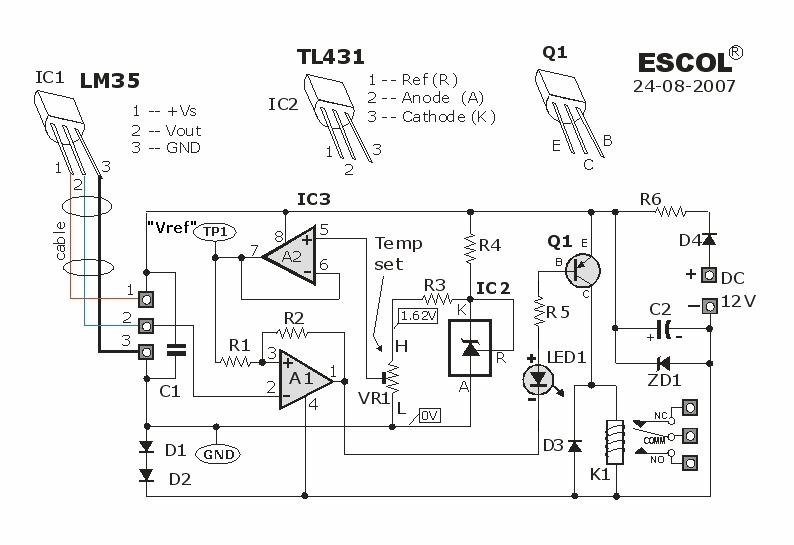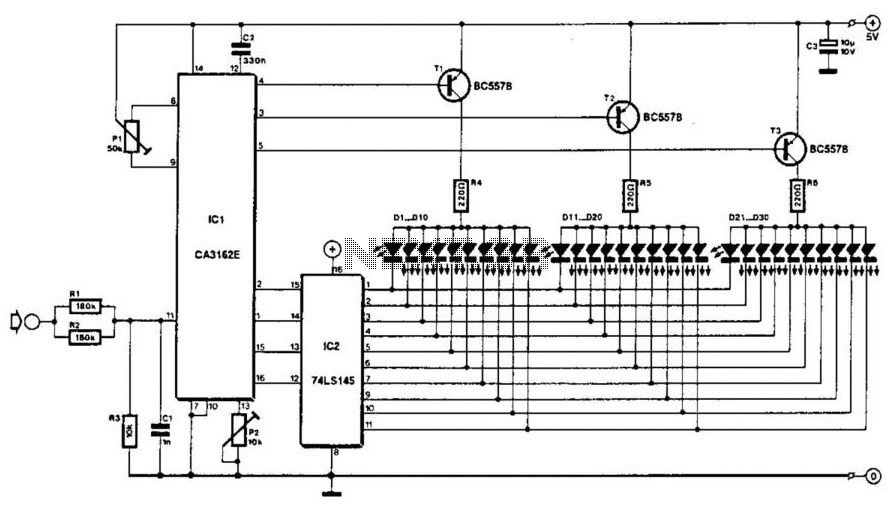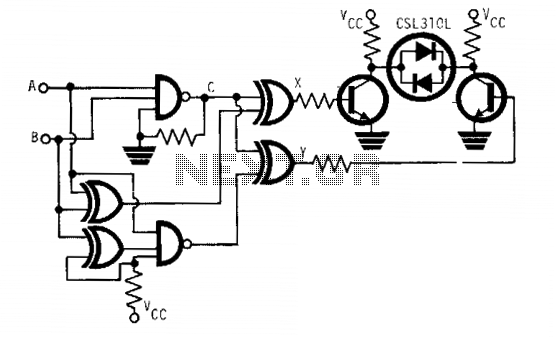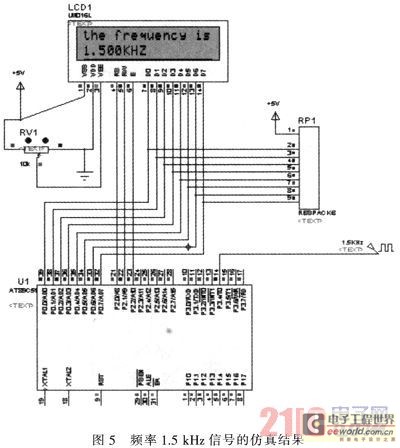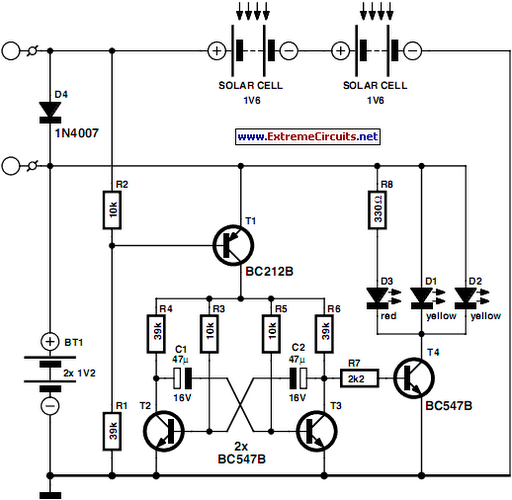
6V Ultra-Bright LED Chasers

This project involves a sequence of Ultra-Bright LEDs that light up briefly in a circular pattern, mounted on a CD. The LEDs flash for 15 milliseconds, followed by a one-second pause, creating a visually appealing effect. The brief flashes and pauses help conserve battery life, allowing for extended use. The design includes a speed control and brightness adjustment, enabling users to modify the LED flashing speed and brightness, which further extends battery life. At maximum brightness, the LEDs produce an intense light, and when multiple units are synchronized, they can illuminate a room dramatically. The LEDs complete four rotations in two seconds at maximum speed, with fewer rotations at slower speeds. The sequence begins with LED #2 and concludes with LED #9. The circuit utilizes a CD74HC4017N high-speed CMOS IC, operating at a maximum voltage of 6.4V and a brief output current of 24mA, ensuring the IC remains cool. The MC14584BCP IC functions as a low-current oscillator, utilizing high-value resistors for minimal power consumption. The circuit features a 10-stage Johnson counter/decoder that sequentially activates the LEDs. The brightness control is achieved through a pulse width modulation (PWM) oscillator, and a sample-and-hold stage regulates the timing of the LED flashes. The LEDs are affixed to a compact disc, which is secured to a plastic box containing the circuit, with battery holders mounted on the lid and pots on the sides.
This project showcases an innovative use of LED technology to create a visually stimulating display while maintaining efficient power consumption. The circular arrangement of LEDs not only enhances the aesthetic appeal but also allows for dynamic light patterns that can be synchronized across multiple units. The CD74HC4017N IC serves as a key component, enabling the sequential activation of the LEDs with its 10 output channels. Its ability to handle brief output currents effectively prevents overheating, ensuring reliable operation.
The MC14584BCP IC contributes to the overall efficiency of the circuit, acting as a low-power oscillator that drives the LED sequences. Its high input resistance allows for the use of larger resistors, which is crucial in minimizing the total current draw from the power source. The design cleverly incorporates a Schmitt trigger oscillator configuration, which is essential for generating clean, stable clock pulses that control the timing of the LED flashes.
The brightness control mechanism, implemented through a PWM oscillator, allows users to adjust the intensity of the LEDs. This feature is particularly advantageous in extending battery life, as lower brightness settings result in reduced power consumption. The sample-and-hold stage, which captures the pulse driving LED #9, further enhances the control over the timing and duration of the LED flashes, allowing for a customizable user experience.
The physical assembly of the project is also noteworthy. The use of a compact disc as a mounting platform for the LEDs not only provides a stable base but also enhances the visual effect as the LEDs illuminate in a circular motion. The integration of a plastic box to house the circuit and battery holders ensures that the components are well-protected and organized. The multiconductor ribbon cable facilitates easy connections between the LEDs and the circuit, simplifying the assembly process.
Overall, this project exemplifies creativity in electronic design, merging functionality with visual appeal while prioritizing energy efficiency. The thoughtful selection of components and configuration strategies results in a unique and engaging LED display that can be enjoyed in various settings.This is a spectacular but completely useless project. It lights Ultra-Bright LEDs in a sequence and each LED flashes brightly very briefly. The LEDs light-up going around and around since they are mounted in a circle (on a CD), then they pause before chasing again. The very brief flash of each LED (15ms) and the pauses (1 second) reduce the averag e current so the battery should last a long time. For user convenience, this project has a stepper speed control and a brightness control. At slower speeds and/or reduced brightness, the battery ’s life is extended considerably. At full brightness, the LEDs flash extremely brightly. More than one of this project grouped together occasionally synchronize, lighting the whole room for a moment. At maximum speed, the LEDs don ’t appear to flash, instead they appear to move from one lighted one to the next, around and around.
They rotate completely for 4 rotations in two seconds, and then turn off for a one second pause then repeat the sequence. At a lower speed, the number of rotations before the pause is less. It will do three rotations, two or even only one rotation at its slowest speed. A sequence of rotations starts with LED #2 and end with LED #9. The CD74HC4017N high-speed Cmos IC is rated for a maximum supply voltage of 7V. It is rated for a maximum continuous output current of 25mA. In this project, the maximum supply voltage is 6. 4V with brand new battery cells and the 24mA output current is so brief that the IC runs cool. The MC14584BCP* IC (Motorola) is an ordinary 4XXX series ” 3V to 18V Cmos IC, with a very low operating current and low output current.
Its extremely high input resistance allows this project to use high value resistors for its timers and oscillators, for low supply current. Its 6 inverters are Schmitt triggers for simple oscillators and very quick switching. IC2 is a 10 stage Johnson counter/decoder. On the rising edge of each clock pulse its outputs step one-at-a-time in sequence. It drives the anode of each conducting LED toward the positive supply. IC1 pins 1 and 2 is a Schmitt trigger oscillator with C3 and C4 paralleled for a very low frequency. R1 and R2 control its frequency and the diodes with R3 combine with the capacitors to produce the 15mS on time for the LEDs.
IC1 pins 5 and 6 is the brightness Pulse Width Modulation oscillator. The pot R7 with the associated diodes and resistors allow it to change the duty-cycle of its output for PWM brightness control. It drives the transistor. IC1 pins 3 and 4 is an inverter. It takes the low time (LEDs off) from the clock oscillator, inverts it to a high and shuts-off the brightness oscillator through diode D6.
IC1 pins 11 and 10 is a sample-and-hold stage. It takes a sample of the pulse driving LED #9 though D3 and R4 and charges C5 in steps. At maximum speed it takes 4 steps for C5 to charge to the Schmitt switching threshold voltage. R5 and D5 slowly discharge C5 for the pause time. The 10 LEDs mount on a Compact-Disc which is glued to a plastic box with contact cement. The box houses the Veroboard circuit in its lower main part with the battery holders on its lid. Multiconductor ribbon cable joins the LEDs to the circuit. The pots mount on the sides of the box. In addition to these changes, R8 = 680 ohms and R9 = 22 ohms. I built one using low-voltage (1. 8V at 20mA) orange Ultra-Bright LEDs. The orange one looks good beside the green one. I wish I knew how to take a slow picture with my son ’s digital camera, so all the LEDs would be lighted, and if I moved it would make nice lighted smears in the picture. 🔗 External reference
This project showcases an innovative use of LED technology to create a visually stimulating display while maintaining efficient power consumption. The circular arrangement of LEDs not only enhances the aesthetic appeal but also allows for dynamic light patterns that can be synchronized across multiple units. The CD74HC4017N IC serves as a key component, enabling the sequential activation of the LEDs with its 10 output channels. Its ability to handle brief output currents effectively prevents overheating, ensuring reliable operation.
The MC14584BCP IC contributes to the overall efficiency of the circuit, acting as a low-power oscillator that drives the LED sequences. Its high input resistance allows for the use of larger resistors, which is crucial in minimizing the total current draw from the power source. The design cleverly incorporates a Schmitt trigger oscillator configuration, which is essential for generating clean, stable clock pulses that control the timing of the LED flashes.
The brightness control mechanism, implemented through a PWM oscillator, allows users to adjust the intensity of the LEDs. This feature is particularly advantageous in extending battery life, as lower brightness settings result in reduced power consumption. The sample-and-hold stage, which captures the pulse driving LED #9, further enhances the control over the timing and duration of the LED flashes, allowing for a customizable user experience.
The physical assembly of the project is also noteworthy. The use of a compact disc as a mounting platform for the LEDs not only provides a stable base but also enhances the visual effect as the LEDs illuminate in a circular motion. The integration of a plastic box to house the circuit and battery holders ensures that the components are well-protected and organized. The multiconductor ribbon cable facilitates easy connections between the LEDs and the circuit, simplifying the assembly process.
Overall, this project exemplifies creativity in electronic design, merging functionality with visual appeal while prioritizing energy efficiency. The thoughtful selection of components and configuration strategies results in a unique and engaging LED display that can be enjoyed in various settings.This is a spectacular but completely useless project. It lights Ultra-Bright LEDs in a sequence and each LED flashes brightly very briefly. The LEDs light-up going around and around since they are mounted in a circle (on a CD), then they pause before chasing again. The very brief flash of each LED (15ms) and the pauses (1 second) reduce the averag e current so the battery should last a long time. For user convenience, this project has a stepper speed control and a brightness control. At slower speeds and/or reduced brightness, the battery ’s life is extended considerably. At full brightness, the LEDs flash extremely brightly. More than one of this project grouped together occasionally synchronize, lighting the whole room for a moment. At maximum speed, the LEDs don ’t appear to flash, instead they appear to move from one lighted one to the next, around and around.
They rotate completely for 4 rotations in two seconds, and then turn off for a one second pause then repeat the sequence. At a lower speed, the number of rotations before the pause is less. It will do three rotations, two or even only one rotation at its slowest speed. A sequence of rotations starts with LED #2 and end with LED #9. The CD74HC4017N high-speed Cmos IC is rated for a maximum supply voltage of 7V. It is rated for a maximum continuous output current of 25mA. In this project, the maximum supply voltage is 6. 4V with brand new battery cells and the 24mA output current is so brief that the IC runs cool. The MC14584BCP* IC (Motorola) is an ordinary 4XXX series ” 3V to 18V Cmos IC, with a very low operating current and low output current.
Its extremely high input resistance allows this project to use high value resistors for its timers and oscillators, for low supply current. Its 6 inverters are Schmitt triggers for simple oscillators and very quick switching. IC2 is a 10 stage Johnson counter/decoder. On the rising edge of each clock pulse its outputs step one-at-a-time in sequence. It drives the anode of each conducting LED toward the positive supply. IC1 pins 1 and 2 is a Schmitt trigger oscillator with C3 and C4 paralleled for a very low frequency. R1 and R2 control its frequency and the diodes with R3 combine with the capacitors to produce the 15mS on time for the LEDs.
IC1 pins 5 and 6 is the brightness Pulse Width Modulation oscillator. The pot R7 with the associated diodes and resistors allow it to change the duty-cycle of its output for PWM brightness control. It drives the transistor. IC1 pins 3 and 4 is an inverter. It takes the low time (LEDs off) from the clock oscillator, inverts it to a high and shuts-off the brightness oscillator through diode D6.
IC1 pins 11 and 10 is a sample-and-hold stage. It takes a sample of the pulse driving LED #9 though D3 and R4 and charges C5 in steps. At maximum speed it takes 4 steps for C5 to charge to the Schmitt switching threshold voltage. R5 and D5 slowly discharge C5 for the pause time. The 10 LEDs mount on a Compact-Disc which is glued to a plastic box with contact cement. The box houses the Veroboard circuit in its lower main part with the battery holders on its lid. Multiconductor ribbon cable joins the LEDs to the circuit. The pots mount on the sides of the box. In addition to these changes, R8 = 680 ohms and R9 = 22 ohms. I built one using low-voltage (1. 8V at 20mA) orange Ultra-Bright LEDs. The orange one looks good beside the green one. I wish I knew how to take a slow picture with my son ’s digital camera, so all the LEDs would be lighted, and if I moved it would make nice lighted smears in the picture. 🔗 External reference

